On our last day of the expedition the landscape was dominated by the Green River Formation, famous for its fish fossils (although none were found in camp).
William C Burton
William C Burton is a Scientist Emeritus at the Florence Bascom Geoscience Center.
Professional Studies/Experience
- Bedrock mapping, western Connecticut (2016-). Detailed bedrock mapping of two 7.5-minute quadrangles in western CT highlands in response to elevated U levels in domestic water wells and ground-water supply and quality in local watershed. Includes complexly deformed Paleozoic plutonic and metamorphic rocks affected by Taconic and Acadian orogenies, plus early Mesozoic sedimentary/volcanic rift basin. Logistical support from CT Geological Survey and Pomperaug River Watershed Coalition.
- Bedrock mapping, southern Virginia (2018-). Detailed mapping of two 7.5-minute quadrangles as an eastern continuation of USGS mapping of Mt. Rogers National Recreation Area. Includes Mesoproterozoic and Neoproterozoic plutonic, metasedimentary, and metavolcanic rocks.
- Volcano hazard monitoring, USGS Volcano Hazards Program. Analyzes incoming remote-sensing data from active volcanic regions, both domestic and international, as part of a USGS volcano monitoring team, and advises on the trend and timing of eruptive activity. Three major monitored eruptions in 2018 that impacted thousands of people include Fuego in Guatemala and Merapi and Agung volcanoes in Indonesia.
- Bedrock mapping, Central VA Seismic Zone (2012-2018). One of a team of USGS, State, and University geologists that studied the Central Virginia Seismic Zone in the wake of the August, 2011 M5.8 earthquake near Mineral, Va. Detailed bedrock mapping of the epicentral region determined that the subsurface fault that triggered the earthquake may have reactivated an ancient contact between granite and schist. First author on one scientific paper and one field guide about the earthquake, and three 1:24,000-scale geologic maps. Coauthor on two 1:24,000-scale geologic maps and one scientific paper.
- Previous mapping and research (1983-2012). Bedrock geologic controls on flow, distribution, and chemistry of ground water; bedrock geologic mapping, geochronology, and structural analysis of complexly deformed orogenic belts; mapping and tectonic history of Neoproterozoic and Mesoproterozoic rocks. 1:12,000 to 1:50,000-scale analog and digital geologic mapping of complexly deformed Mesoproterozoic metamorphic and igneous rocks of the central and northern Appalachian mountains; Neoproterozoic metavolcanic and metasedimentary rocks of accreted terranes in the southern Appalachians; autochthonous Neoproterozoic through Ordovician metasedimentary and metavolcanic rocks of the southern, central and northern Appalachians; Silurian and Devonian metamorphic and igneous rocks of the northern Appalachians; Neoproterozoic to early Paleozoic volcanic, intrusive, and sedimentary rocks of the Jebel Saghro range, Morocco; Neoproterozoic intrusive, volcanic and sedimentary rocks of northern Madagascar; and clastic sediments and volcanics of the Early Mesozoic rift basins,
Science and Products
Database for the Geologic Map of the South Boston 30' x 60' Quadrangle, Virginia and North Carolina
Photoluminescence Imaging of Whole Zircon Grains on a Petrographic Microscope - An Underused Aide for Geochronologic Studies
Digital Data for the Geology of the Mineral and Lake Anna West quadrangles, Virginia
Geologic map of the South Boston 30' × 60' quadrangle, Virginia and North Carolina
Geologic map of the Ferncliff and Louisa quadrangles, Louisa, Fluvanna, and Goochland Counties, Virginia
Geologic Map of the Frederick 30' x 60' Quadrangle, Maryland, Virginia, and West Virginia
Bedrock Geologic Map of the Headwaters Region of the Cullasaja River, Macon and Jackson Counties, North Carolina
Geologic Map of Loudoun County, Virginia
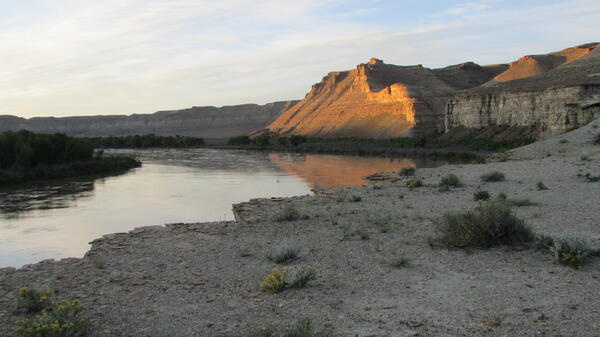
On our last day of the expedition the landscape was dominated by the Green River Formation, famous for its fish fossils (although none were found in camp).
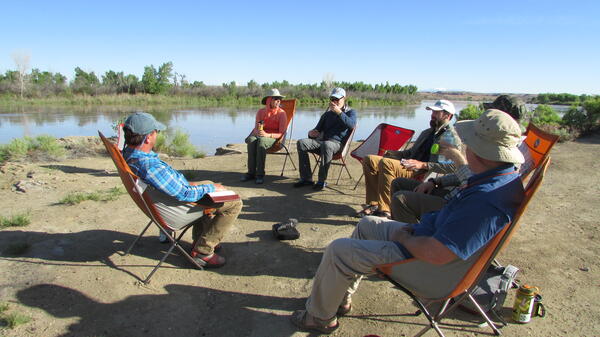
An integral part of each segment of the expedition is a recorded dialogue in which participans reflect on such things as Powell's legacy, the future of the West in light of water and energy issues, and what personal growth has occurred as a result of the expedition.
An integral part of each segment of the expedition is a recorded dialogue in which participans reflect on such things as Powell's legacy, the future of the West in light of water and energy issues, and what personal growth has occurred as a result of the expedition.
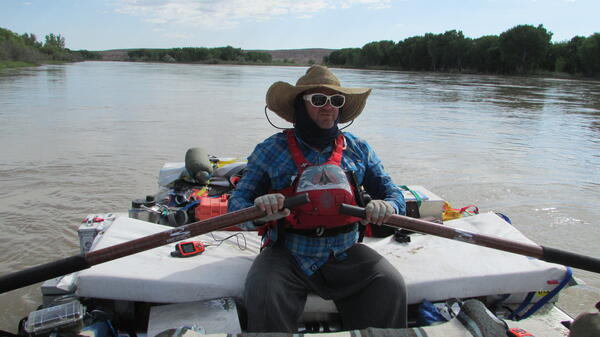
Starting two years ago, Professor Tom Minckley, from the University of Wyoming geology department, conceived and organized the Sesquicentennial Colorado River Exploring Expedition (SCREE), also known as the Powell 150 expedition. The USGS joined as a partner last year.
Starting two years ago, Professor Tom Minckley, from the University of Wyoming geology department, conceived and organized the Sesquicentennial Colorado River Exploring Expedition (SCREE), also known as the Powell 150 expedition. The USGS joined as a partner last year.
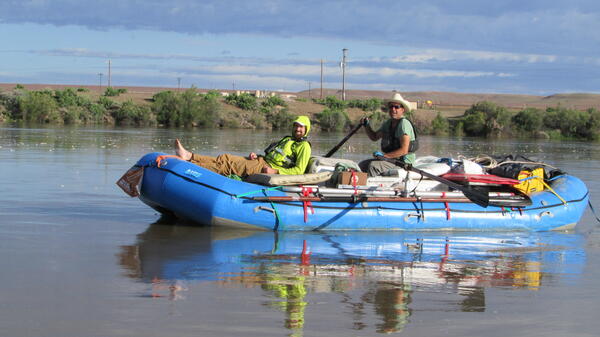
USGS geologist Graham Lederer (L) wrote a song about the expedition while floating down the river, and Professor Pat Likut (R), who teaches art at the University of Wyoming, did landscape sketches that he will later turn into oil paintings.
USGS geologist Graham Lederer (L) wrote a song about the expedition while floating down the river, and Professor Pat Likut (R), who teaches art at the University of Wyoming, did landscape sketches that he will later turn into oil paintings.
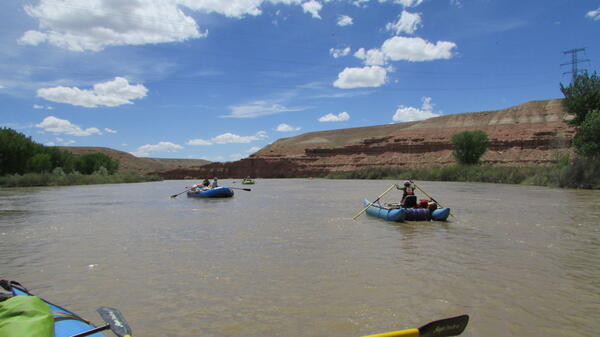
The brick-red, flat-lying Duchesne Formation sandstones dominated the landscape for a couple days. Its bluffs are a favorite nesting spot for cliff swallows, of which we saw many, and peregrine falcons, of which we saw two.
The brick-red, flat-lying Duchesne Formation sandstones dominated the landscape for a couple days. Its bluffs are a favorite nesting spot for cliff swallows, of which we saw many, and peregrine falcons, of which we saw two.
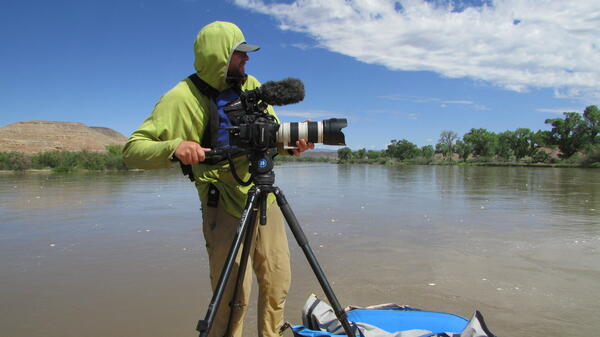
University of Wyoming grad student (media and communications) Ben Kraushaar is also an accomplished filmmaker, and is making a film of the expedition using both eyelevel shots and lofty drone aerials. He was instrumental in getting equipment of all types donated to the expedition.
University of Wyoming grad student (media and communications) Ben Kraushaar is also an accomplished filmmaker, and is making a film of the expedition using both eyelevel shots and lofty drone aerials. He was instrumental in getting equipment of all types donated to the expedition.
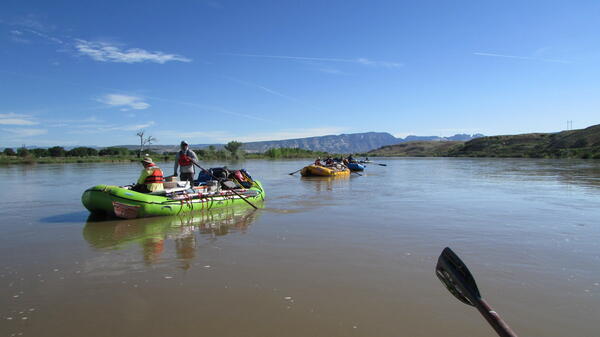
Team D enters the middle of the Uinta basin on Day 2, with Split Mountain still visible. The flow of the river greatly increased that day due to a controlled release at Flaming Gorge Dam. The high flow is meant to carry the larvae of an endangered species of sucker fish into bordering wetlands, where the larvae can grow under more protected conditions.
Team D enters the middle of the Uinta basin on Day 2, with Split Mountain still visible. The flow of the river greatly increased that day due to a controlled release at Flaming Gorge Dam. The high flow is meant to carry the larvae of an endangered species of sucker fish into bordering wetlands, where the larvae can grow under more protected conditions.
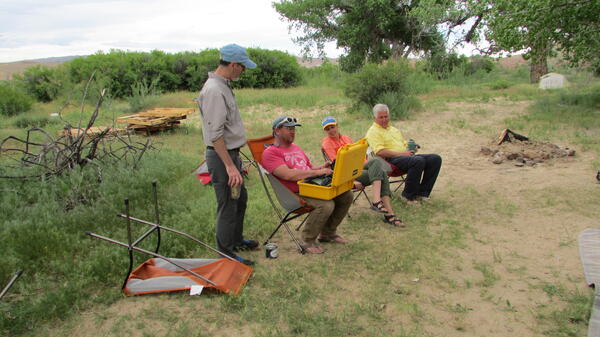
One of the ongoing experiments on the expedition is a bioacoustic survey monitor, which will parse recorded nighttime sounds into species and numbers of individuals. Here Tom Minckley explains it to USGS scientists Mitch Eaton, Jamie Delano, and John Parks.
One of the ongoing experiments on the expedition is a bioacoustic survey monitor, which will parse recorded nighttime sounds into species and numbers of individuals. Here Tom Minckley explains it to USGS scientists Mitch Eaton, Jamie Delano, and John Parks.
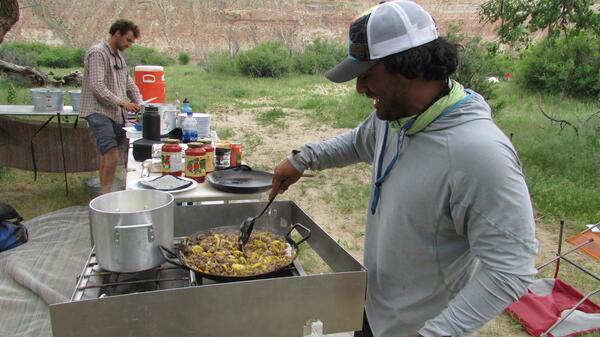
Ben Capelin and Austin Alvarado have multi-faceted roles on the expedition, serving as expert boatmen, talented cooks, evening companions, and contributors to any discussions.
Ben Capelin and Austin Alvarado have multi-faceted roles on the expedition, serving as expert boatmen, talented cooks, evening companions, and contributors to any discussions.
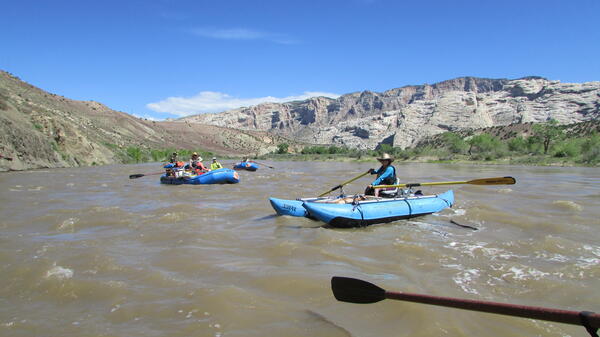
In high-flow conditions, Team D took off from Split Mountain campground in 6 rafts. Split Mountain is shown in the background.
In high-flow conditions, Team D took off from Split Mountain campground in 6 rafts. Split Mountain is shown in the background.
Paleozoic and Mesozoic tectonic events west of the Waterbury Dome: Results of new mapping in the western Connecticut Highlands
Photoluminescence imaging of whole zircon grains on a petrographic microscope—An underused aide for geochronologic studies
The refractory nature of zircon to temperature and pressure allows even a single zircon grain to preserve a rich history of magmatic, metamorphic, and hydrothermal processes. Isotopic dating of micro-domains exposed in cross-sections of zircon grains allows us to interrogate this history. Unfortunately, our ability to select the zircon grains in a heavy mineral concentrate that records the most ge
Geochronologic age constraints on tectonostratigraphic units of the central Virginia Piedmont, USA
New geologic mapping coupled with uranium-lead (U-Pb) zircon geochronology (sensitive high-resolution ion microprobe-reverse geometry [SHRIMP-RG] and laser ablation-inductively coupled plasma-mass spectrometry [LA-ICP-MS]) analyses of 10 samples, provides new constraints on the tectonostratigraphic framework of the central Virginia Piedmont. Detrital zircon analysis confirms that the Silurian-Devo
Geology of the Mineral and Lake Anna West Quadrangles, Virginia
Preliminary bedrock geologic map of the Lahore 7.5-minute quadrangle, Orange, Spotsylvania, and Louisa Counties, Virginia
Geologic map of the Washington West 30’ × 60’ quadrangle, Maryland, Virginia, and Washington D.C.
Geology of the eastern Piedmont in Virginia
Geologic framework and evidence for neotectonism in the epicentral area of the 2011 Mineral, Virginia, earthquake
Geology and neotectonism in the epicentral area of the 2011 M5.8 Mineral, Virginia, earthquake
Subsurface geologic features of the 2011 central Virginia earthquakes revealed by airborne geophysics
Stitching the western Piedmont of Virginia: Early Paleozoic tectonic history of the Ellisville Pluton and the Potomac and Chopawamsic Terranes
Bedrock geologic and joint trend map of the Pinardville quadrangle, Hillsborough County, New Hampshire
Science and Products
Database for the Geologic Map of the South Boston 30' x 60' Quadrangle, Virginia and North Carolina
Photoluminescence Imaging of Whole Zircon Grains on a Petrographic Microscope - An Underused Aide for Geochronologic Studies
Digital Data for the Geology of the Mineral and Lake Anna West quadrangles, Virginia
Geologic map of the South Boston 30' × 60' quadrangle, Virginia and North Carolina
Geologic map of the Ferncliff and Louisa quadrangles, Louisa, Fluvanna, and Goochland Counties, Virginia
Geologic Map of the Frederick 30' x 60' Quadrangle, Maryland, Virginia, and West Virginia
Bedrock Geologic Map of the Headwaters Region of the Cullasaja River, Macon and Jackson Counties, North Carolina
Geologic Map of Loudoun County, Virginia

On our last day of the expedition the landscape was dominated by the Green River Formation, famous for its fish fossils (although none were found in camp).
On our last day of the expedition the landscape was dominated by the Green River Formation, famous for its fish fossils (although none were found in camp).

An integral part of each segment of the expedition is a recorded dialogue in which participans reflect on such things as Powell's legacy, the future of the West in light of water and energy issues, and what personal growth has occurred as a result of the expedition.
An integral part of each segment of the expedition is a recorded dialogue in which participans reflect on such things as Powell's legacy, the future of the West in light of water and energy issues, and what personal growth has occurred as a result of the expedition.

Starting two years ago, Professor Tom Minckley, from the University of Wyoming geology department, conceived and organized the Sesquicentennial Colorado River Exploring Expedition (SCREE), also known as the Powell 150 expedition. The USGS joined as a partner last year.
Starting two years ago, Professor Tom Minckley, from the University of Wyoming geology department, conceived and organized the Sesquicentennial Colorado River Exploring Expedition (SCREE), also known as the Powell 150 expedition. The USGS joined as a partner last year.

USGS geologist Graham Lederer (L) wrote a song about the expedition while floating down the river, and Professor Pat Likut (R), who teaches art at the University of Wyoming, did landscape sketches that he will later turn into oil paintings.
USGS geologist Graham Lederer (L) wrote a song about the expedition while floating down the river, and Professor Pat Likut (R), who teaches art at the University of Wyoming, did landscape sketches that he will later turn into oil paintings.

The brick-red, flat-lying Duchesne Formation sandstones dominated the landscape for a couple days. Its bluffs are a favorite nesting spot for cliff swallows, of which we saw many, and peregrine falcons, of which we saw two.
The brick-red, flat-lying Duchesne Formation sandstones dominated the landscape for a couple days. Its bluffs are a favorite nesting spot for cliff swallows, of which we saw many, and peregrine falcons, of which we saw two.

University of Wyoming grad student (media and communications) Ben Kraushaar is also an accomplished filmmaker, and is making a film of the expedition using both eyelevel shots and lofty drone aerials. He was instrumental in getting equipment of all types donated to the expedition.
University of Wyoming grad student (media and communications) Ben Kraushaar is also an accomplished filmmaker, and is making a film of the expedition using both eyelevel shots and lofty drone aerials. He was instrumental in getting equipment of all types donated to the expedition.

Team D enters the middle of the Uinta basin on Day 2, with Split Mountain still visible. The flow of the river greatly increased that day due to a controlled release at Flaming Gorge Dam. The high flow is meant to carry the larvae of an endangered species of sucker fish into bordering wetlands, where the larvae can grow under more protected conditions.
Team D enters the middle of the Uinta basin on Day 2, with Split Mountain still visible. The flow of the river greatly increased that day due to a controlled release at Flaming Gorge Dam. The high flow is meant to carry the larvae of an endangered species of sucker fish into bordering wetlands, where the larvae can grow under more protected conditions.

One of the ongoing experiments on the expedition is a bioacoustic survey monitor, which will parse recorded nighttime sounds into species and numbers of individuals. Here Tom Minckley explains it to USGS scientists Mitch Eaton, Jamie Delano, and John Parks.
One of the ongoing experiments on the expedition is a bioacoustic survey monitor, which will parse recorded nighttime sounds into species and numbers of individuals. Here Tom Minckley explains it to USGS scientists Mitch Eaton, Jamie Delano, and John Parks.

Ben Capelin and Austin Alvarado have multi-faceted roles on the expedition, serving as expert boatmen, talented cooks, evening companions, and contributors to any discussions.
Ben Capelin and Austin Alvarado have multi-faceted roles on the expedition, serving as expert boatmen, talented cooks, evening companions, and contributors to any discussions.

In high-flow conditions, Team D took off from Split Mountain campground in 6 rafts. Split Mountain is shown in the background.
In high-flow conditions, Team D took off from Split Mountain campground in 6 rafts. Split Mountain is shown in the background.
Paleozoic and Mesozoic tectonic events west of the Waterbury Dome: Results of new mapping in the western Connecticut Highlands
Photoluminescence imaging of whole zircon grains on a petrographic microscope—An underused aide for geochronologic studies
The refractory nature of zircon to temperature and pressure allows even a single zircon grain to preserve a rich history of magmatic, metamorphic, and hydrothermal processes. Isotopic dating of micro-domains exposed in cross-sections of zircon grains allows us to interrogate this history. Unfortunately, our ability to select the zircon grains in a heavy mineral concentrate that records the most ge
Geochronologic age constraints on tectonostratigraphic units of the central Virginia Piedmont, USA
New geologic mapping coupled with uranium-lead (U-Pb) zircon geochronology (sensitive high-resolution ion microprobe-reverse geometry [SHRIMP-RG] and laser ablation-inductively coupled plasma-mass spectrometry [LA-ICP-MS]) analyses of 10 samples, provides new constraints on the tectonostratigraphic framework of the central Virginia Piedmont. Detrital zircon analysis confirms that the Silurian-Devo

